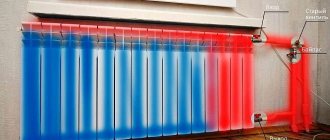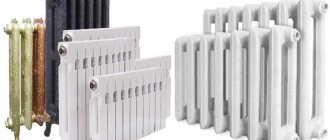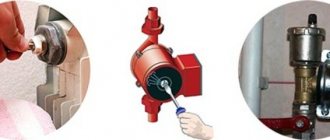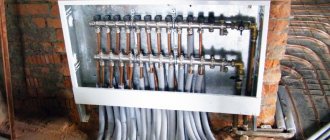Heating radiators provide comfortable temperature conditions in the apartment during the cold season. Traditionally, steel and cast iron heating devices were installed during the construction of a house and connected directly to the pipeline, without shut-off valves. In such situations, replacing batteries in an apartment involves additional hassle.
Replacing heating batteries in an apartment
Reasons for replacement
There are a number of reasons why heating appliances in an apartment building have to be changed. These include:
- Physical wear and tear of equipment
. Old batteries deteriorate, lose their tightness, and during pressure testing of the system after emergency or seasonal maintenance work, or simply during operation, they leak. - Insufficient heating
. An old radiator differs from a new one in a thick layer of deposits inside the housing, which is why the coolant cannot fully transfer heat to the room. - Insufficient power
. In multi-apartment panel buildings, convectors can be installed, the power of which is not enough to fully heat large rooms. - Unattractive appearance
. The battery can be replaced for aesthetic reasons - modern models have an attractive, stylish design.
After making a decision to install new heating devices instead of physically or morally outdated ones, it is necessary to determine who will finance and carry out the work - the management company or the owner of the apartment.
Old cast iron battery
Wrong choice of tap
At first glance, brass taps are better suited for installing, for example, the Mayevsky system for removing air locks. They are more durable, stronger, and not subject to mechanical stress. But the connections of such taps with other parts of the structure, especially plastic ones, often allow leaks, especially when silicone, which is popular today, is used to seal the connections rather than tow.
Whose responsibility is it to replace heating radiators in an apartment?
Let's figure out who should change the batteries in a privatized apartment. In accordance with Decree of the Government of the Russian Federation No. 491 (came into force in August 2006), the entire heating system in an apartment building is classified as common property. Its composition (according to paragraph No. 6 of the Rules) includes heating network equipment, risers, valves (shut-off and for regulation), general house heat meters, as well as heating devices (radiators).
Accordingly, in the event of physical wear and tear of the batteries, leaks or overgrowth from the inside, the replacement of heating radiators in the apartment is carried out by the management company (ZhEK), to whose account residents receive monthly deductions for major repairs. It is the management company that is responsible for the maintenance and servicing of common property, part of which is the heating radiators in the apartments.
In practice, it is easier to achieve free replacement of emergency heating appliances in a municipal apartment. Housing office workers often force residents of privatized apartments to independently purchase a battery and pay for dismantling and installation work. But in accordance with current legislation, the purchase of a heating device and all work on its installation must be paid for from money collected for major repairs of the housing stock, regardless of whether the apartment is privatized or not.
In an effort to save money, management companies prefer to repair old batteries until they begin to crumble. Therefore, it may take a lot of effort to achieve free installation of new radiators to replace emergency ones.
Emergency heating radiator
If residents decide to install a new, modern heating device to replace an obsolete but serviceable one, they will have to resolve this issue on their own by paying for the purchase and installation.
Installation technology.
Let us consider in detail the technology of installation with steel pipes, as the most common case. There are two options here, welding or threading. The optimal technology is gas welding, since in comparison with threads there are no vulnerabilities in the form of slips, without which no installation on a threaded connection is possible. In short, pipes usually always leak, since they are subject to loads from thermal expansion, and installation with a large number of fittings does not look as attractive as a welded solid steel pipe.
Details in the photo of the installation of the radiator on the thread and our modification with gas welding.
As for gas welding in comparison with electric arc welding, gas welding has 3 advantages:
— the ability to correct inaccuracies in the installation of builders by heating and bending fragments of the riser using a gas burner.
— absence of slag inside the pipe, narrowing the cross-section.
- no sparks from molten metal.
Replacement of heating devices through the housing office
So, replacement of heating devices is carried out through the housing office only in situations where the established service life of the radiators has been exceeded, they are in disrepair and cannot be repaired. In other cases, when batteries leak, minor repairs are performed.
According to current standards, the service life of a cast iron radiator is 15-30 years when used in an open system and 30-40 years when used in a closed system. But, even if we are talking about an apartment building where the batteries were installed more than 40 years ago, the operating company is often limited to only repairing the radiator, since replacement is included in the list of major repairs, the timing of which may not yet be determined.
Replacing the battery using gas welding
To replace emergency batteries free of charge, residents must contact the Housing Office with a corresponding application. It is recommended to prepare two copies of the application and mark both as having been accepted by the responsible person at the housing office. The application and its copy are marked with the number, date and legible signature of the responsible person.
Duplicating the document will help if problems arise in the future related to the reluctance of the management company to change emergency batteries at the expense of the capital repair budget. But residents must defend their rights, since they paid for the replacement of old radiators through monthly payments for housing, maintenance and major repairs of the common property of the house.
Preparatory stage
After the old heating equipment is dismantled, markings for new batteries are applied to the wall, indicating the mounting locations for the bracket. It is produced based on the size of the radiator and the distance between sections. The building level will help you draw verticals and horizontals correctly. For ease of work, you can mark the outline of the battery on the wall.
In the places where the brackets will be attached, holes must be drilled for them. Based on the type of fastening of the brackets, they are screwed or driven into the wall. If cracks and deep chips have formed in the wall, before installing the radiators on the brackets, it is necessary to eliminate all surface defects by cleaning and covering it with a cement composition.
You can increase the heat transfer of the batteries and avoid pointless heating of the walls if you attach foil insulation behind the radiator. It is laid according to the size of the battery, covering the space up to the windowsill. As a result, heat waves will be directed into the room.
Coordination of replacement of system elements
Replacing the heating system in an apartment requires approval from the utility company. You must obtain permission by contacting the administration of the operating organization servicing the house.
Even at the design stage of an apartment building, the heating system is calculated - the number and power of heating devices, their location, volume and temperature of the coolant, etc. are determined. Replacing heating batteries with models with different performance characteristics may result in deterioration of the heating system in the house. If unauthorized replacement heating batteries do not meet the design parameters, this provokes an emergency situation.
Removing the battery from the brackets
If you plan to change the heating radiators in the apartment yourself - at your own expense, you will need to submit a number of documents for consideration
:
- Application with attached technical passport for the apartment.
- A document confirming ownership of the apartment.
- Expertise-approved thermal calculations for new heating appliances.
- Certificates of conformity for all components (radiators, fittings, pipes, fittings, etc.).
Note! If the radiator is replaced with a similar heating device, permission is not required. In this case, the management company is only warned about the work being carried out.
Thermal calculation expertise is required if you plan to:
- change heating batteries by installing devices of a different type, with different technical characteristics;
- increase the power of the existing radiator by adding links;
- move the heating device to another part of the room.
An expert should check whether upgrading the heating system will not disrupt the thermal balance of the house. The examination is a paid service and is performed at the expense of the apartment owner.
From the moment the documents are submitted to the management organization until the permit is issued, it can take up to 2 months. After receiving permission, you must submit an application to turn off the riser and drain the coolant from the corresponding section of the system.
After replacing the heating batteries in the apartment, an application for technical examination is submitted - specialists and representatives of the management company check the correct installation and compliance of the heating devices with those that were approved for installation.
Recommendations from experts
- Experts recommend installing a special valve or valve to regulate the flow of water in the system. By decreasing or increasing the coolant pressure, you can regulate the temperature in the apartment.
- This is convenient during repairs, when you need to repair or completely replace only one heating device, without shutting down the entire system.
- The thermal head is installed together with the valve. They are installed only in a single-pipe system. Otherwise, the heating devices will not work well.
- To remove air from the pipes, you need to install a Mayevsky valve on each battery. The air is released at the very beginning of the heating season or already in progress.
Valve and thermal head
Convenient time for work
The period of time when it is better to change heating batteries is the period between the end of one heating period and the beginning of another. During the heating interval, hydraulic tests of the system can be carried out. It is important to obtain information in advance from the management company about the timing of the tests in order to schedule battery replacement for other days.
It is better to change radiators in the summer
Due to an emergency situation, it may be necessary to quickly change heating devices. For a privatized apartment, emergency replacement of radiators is a paid service, since their performance must be monitored by the owner of the apartment and promptly notified to the operating company about leaks or physical wear and tear of old batteries that have expired.
What connection material is better to choose?
When replacing radiators, many different materials are used. Before starting repairs, it is important not only to select the optimally suitable battery model, but also the pipes for connecting to the system. The main connection options are welding (steel requirements), propylene and metal-plastic.
Battery welding
Metal-plastic pipes are the most popular. They are lightweight, affordable and easy to install. Such pipes look neat in the interior. However, metal-plastic has disadvantages. The material burns, and during installation it is necessary to make several connections, the condition of which must be constantly monitored to avoid leaks.
Plastic pipes will cost more, but their quality and service life are 100% worth the price. The plastic does not rot or corrode, and the connections are highly durable, which reduces the risk of leakage to zero. Plastic has no disadvantages. The only thing that can spoil the mood is incorrect assembly.
Polypropylene pipes for heating
Steel pipes are the most durable of all. They are resistant to any damage, heat up well, which means they will also warm the air in the room. The disadvantages of such pipes are the occurrence of rust and complex installation that requires welding.
We change batteries ourselves
Before replacing the heating device with a new one, decide on the scope of work. If the battery is connected to horizontal pipes that come out of the wall, only the heating device itself is changed. In other cases, it is desirable to replace the riser so as not to cut metal pipes.
To replace the riser, you will need to negotiate with the neighbors above and below the floor - in this case, the pipeline is connected to their heating devices. If the neighbors do not want to start repairs, you can choose one of three options:
- cut the riser from top and bottom, cut external threads and install a new pipeline from modern materials;
- cut off the supply pipes next to the old radiator and connect the new heating device to the old pipeline;
- cut the supply pipes at the bend and connect new supply pipes with a bypass to the vertical sections of the riser.
Replacing heating radiators using welding
Steel pipes require installation using gas welding, for which you should hire professionals with the appropriate equipment. When installing a heating radiator yourself, it is more convenient to use metal-plastic pipes (a prerequisite is press fittings, not threaded connections), galvanized steel frames with installation on bends, corrugated or ordinary stainless steel pipes.
Removing old batteries
Before changing the batteries in the apartment, it is important to make sure that the management company employees have shut off the coolant supply and emptied the riser. Residents replacing radiators should have a convenient container ready to drain any remaining water from the radiator during dismantling.
If a decision is made to replace the heating radiator along with the riser or only with the supply pipes, then the pipeline is simply cut in the selected places. In the case when a new battery is installed to replace the old one, the heating device is removed according to the following scheme
:
- twist the locknut on the drive until it stops (it is what secures the battery), the operation is performed on the upper and lower connections;
- determine the cutting locations on the supply pipes, and it is necessary to leave at least a centimeter of thread;
- marks are made using a level - the cut must be vertical and even, otherwise it will be difficult to install a new battery;
- cut the pipes according to the marks and remove the battery to be replaced from the wall brackets;
- remove the brackets;
- If necessary, the edges of threaded pipes are trimmed by tightening the locknut and removing burrs.
Removing the old plate battery
Preparation for installation
At the stage of preparing to modernize the heating system in an apartment with your own hands, you should develop a connection diagram, determine the length and diameter of all sections of the pipeline, the number and type of components. The list of materials used must be approved by the specialists issuing permission to replace the battery. The scheme necessarily provides for the installation of shut-off valves on the supply line and a bypass - a jumper that allows you to turn off the radiator without blocking the flow of coolant in the house system.
Work on installing a new radiator begins after the location of the heating device has been determined:
- the gap between the floor and the lower edge of the radiator is at least 10-15 cm;
- distance from the top edge of the battery to the window sill - from 15 cm;
- a gap of 3-4 cm is left between the wall and the housing of the heating device (adjustable when installing the brackets).
Pipes, taps, fittings for battery installation
Note! Failure to comply with the recommended distances impairs the circulation of heated air and reduces the thermal efficiency of the radiator.
Installing a new battery
If the heating system riser has been dismantled, first of all, external threads are cut on the protruding parts of the old pipes for fastening steel or metal-plastic pipes using appropriate fittings. A bypass jumper is installed between the supply and return pipes using tees. After the bypass, a ball valve with an American connection is mounted on each of the horizontal pipes.
Threaded connections are sealed with flax strands and silicone sealant (or oil paint). This sealing option is allowed for connecting cast iron radiators; unlike FUM tape or thread, the seal is not squeezed out or torn. Sealants that do not dry out tend to squeeze out, while sealants that harden tend to dry out, causing the battery to leak.
Installing a new battery
To connect a heating device to the system yourself, you must adhere to a certain work technology
:
- Assemble the radiator. The lower unused hole is closed with a standard plug, and a Mayevsky tap is mounted on the upper pipe (the drainer will help remove the air lock when filling a new heating device).
- Foot nuts with right-hand and left-hand threads are installed on the radiator inlets, using paronite seals for sealing (rubber seals can dry out and crack when exposed to high temperatures).
- The radiator is installed on a stand of suitable height so that the adapter nuts can be connected to the American ones on the ball valves.
- After fitting, markings are made on the wall for installing brackets, holes are drilled and all four fasteners are mounted. To ensure that the battery is secured correctly, check the position of the brackets with a level - it should be horizontal.
- The radiator is connected to the supply pipes (it is important to properly seal all connections) and hung on brackets.
Upon completion of the work, representatives of the management organization fill the system with coolant - at this stage, the tightness of the connections and the heating device itself is checked. Using the Mayevsky tap, bleed the air from the battery when filling the system. To do this, use a special key or screwdriver to turn a special element. When a trickle of water flows from the hole, close the tap.
Note! To replace radiators in the entire apartment, you need to turn off each involved riser one by one, and you need to notify the management company.
Self-removal of radiators
Unscrewing the threaded connections at the radiator inlet
Before removing the old equipment, you should consider the feasibility of replacing the internal wiring. Pipes can become clogged with limescale and dirt, especially at joints and bends. Instead, it is advisable to install modern polypropylene sections.
Removing batteries is carried out in the following sequence.
- Unscrewing threaded connections at the radiator inlet. If the joint does not yield, it can be heated with a torch. If the product is to be disposed of, it is simply cut off from the pipe.
- The battery is carefully removed from the brackets. To facilitate further transportation, the water must be drained from it. There is no point in throwing away the dismantled element, as it can be profitably sold for scrap at a railway collection point.
- The pipes are cut at a distance of 15-20 cm from the riser. The ends are threaded, to which adapter fittings for plastic wiring are screwed.
- To improve the heat transfer of the heaters, foil penofol is attached to the opening where they will hang. The base is first cleared of debris and primed. This will ensure uniform distribution of the heated air flow throughout the entire volume of the room.
When cutting and welding metal, it is recommended to protect walls and floors with plywood or cardboard shields moistened with water. Sparks can damage the finish and cause a fire.











